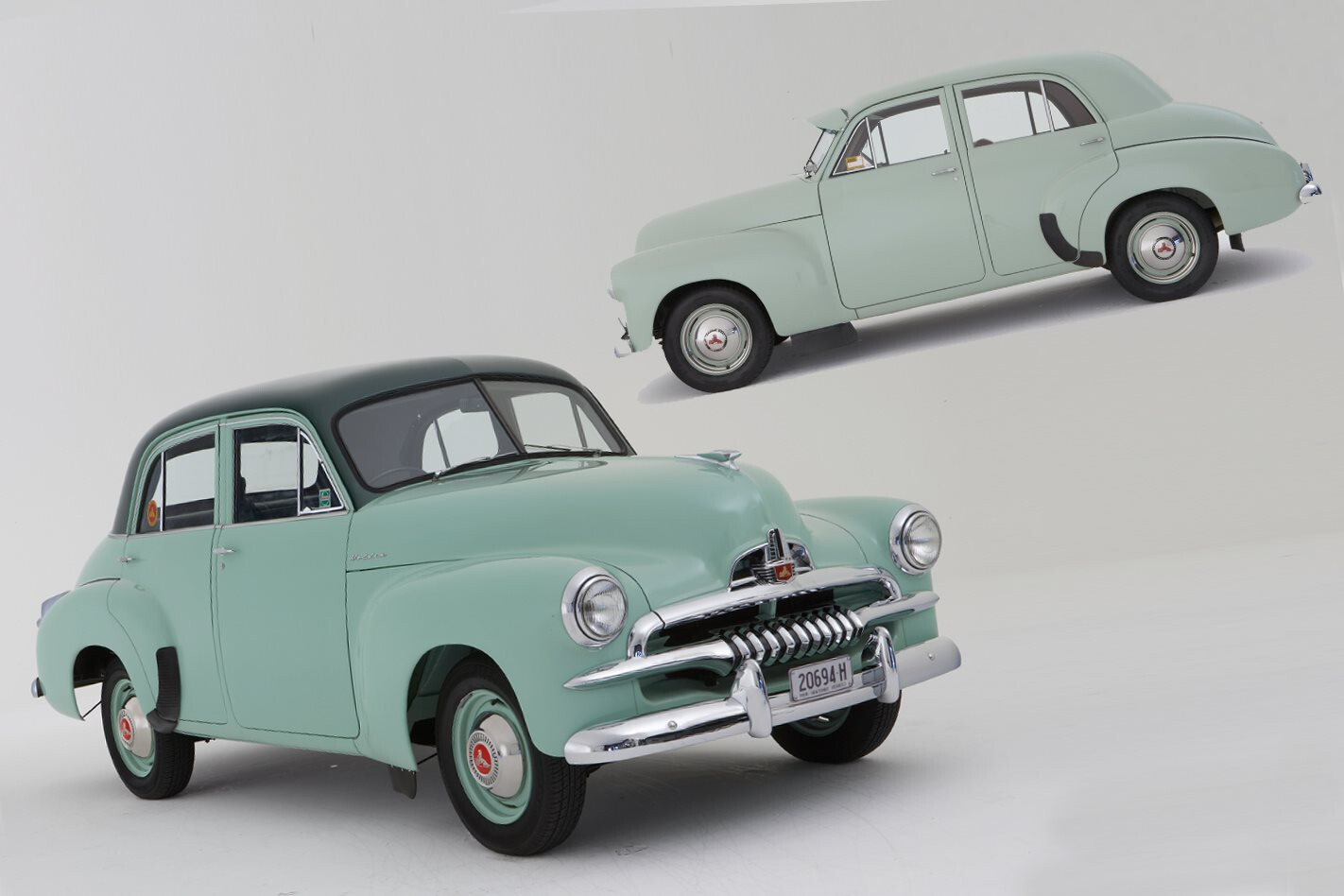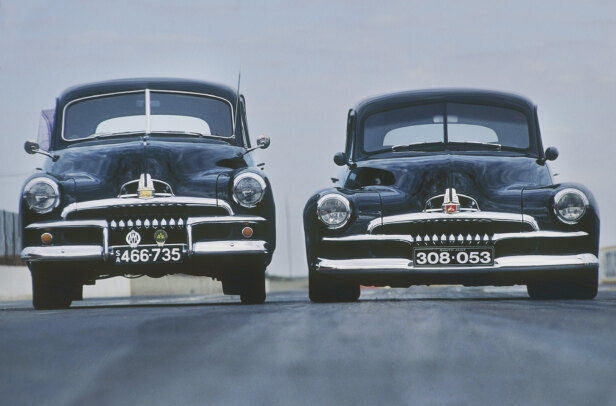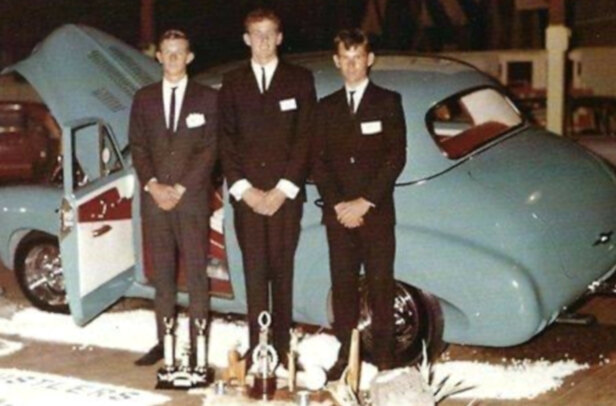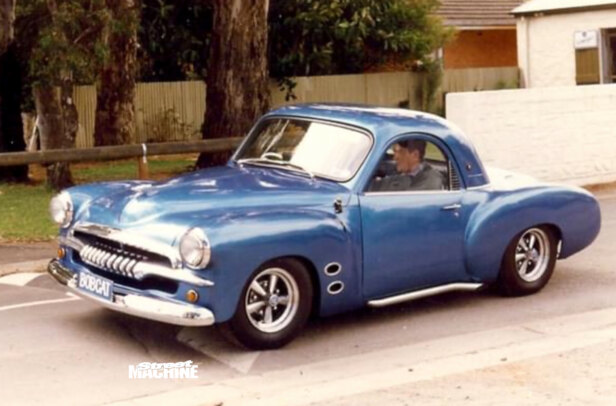This article on FX-FJ Holdens was originally published in the February 2007 issue of Street Machine
BEFORE anyone gets too upset, we should point out that the very first Holden (and the first mass-produced Australian motor car) was never referred to as the FX by GMH itself. To the public the car was simply a Holden, while it was known within the organisation as the 48/215. The FX moniker was applied later, to differentiate it from the FJ and FE models, and while some fanatics dislike the term, it is now part of Australian culture and that’s good enough for us.
The initial range was simple, with one body style, one trim level and one drivetrain combination: a 60hp, 132ci (2.15-litre) straight six, backed by a three-speed column shift gearbox, with synchromesh only in second and third.
A utility was added to the range in January 1951, technically known as the 50/2106.
This was followed by the Business Sedan (or 48/215-257 if you must) in July 1953. The Business Sedan offered such luxuries as interior door pull handles, map pocket, reinforced seat cushions and padding, tougher rubber floor mats, a passenger handrail and aluminium kickplates on the seat corners and over the rear wheelarches. Holden sold a total of 120,402 FXs, reaching the number one position in passenger car sales in 1950.
Holden FX in detail:
1. Door-lock barrels were fitted to the passenger-side only on FX. The door-lock button on early FXs was inconveniently located at the rear of the door, thus early bodies are referred to as rear lockers. Early-model FXs ran 15×3.5 tyres; later cars were upgraded to 15×4 widies. Hard to imagine now but even side-mirrors were an option!
2. H-O-L-D-E-N bonnet badges were an FX-only deal. Blinkers were never a factory option on FX-FJs — you used hand signals or fitted blinkers yourself. The FX grille was made from 29 blades; time-consuming and expensive.
3. FXs ran spaced out H-O-L-D-E-N badges on the boot too. The wings of the central stop/tail-light were painted body colour. Safety reflectors like these are aftermarket, never factory fitment. Regulations in some states required that the tail-lights could be switched on from outside the vehicle — these cars have a small toggle-switch under one of the tail-light win.
4. Early cars (’48–’49) had a raised ridge running over the top of the glovebox.Dashboard design was simple: a big speedo, with small warning lights on the left and the fuel gauge on the right. Starter button was located on the right-hand side of the dash, under the headlight switch. Horn ring is a NASCO accessory. FXs were initially available only with leather or cloth trim — PVC became available.
WARREN ARNEIL, 1952 Holden
WARREN was an avid drag racer in the Castlereagh era, running a tough, injected Anglia van with a mate, and later an A/A dragster. “Then they closed the track and I got into early Holdens,” says Warren, who now has a collection of five Humpies. “When I bought this one in 1990, it had been sitting in a shed since 1971,” he says. “It had done 50,000 miles and had two pinhole spots of rust in the guards.”
Plenty of room in the engine bay! Warren’s engine features a rare alloy Nasco rocker cover. The tin can in front of the battery is a brake fluid reservoir – the master cylinder is located under the floor
Warren, with his sons Daniel and Scott, stripped the car back to bare metal anyway and applied a fresh coat of Barton Grey duco. Warren has added a rare-as-hen’s-teeth aluminium Nasco tappet cover and not much else.
Holden FJ
The FJ was a simple facelift of the FX, released in late 1953. Besides a host of small styling changes, the FJ added the luxurious Special to the range, as well as the panel van. The Special added plenty of little luxuries, including a cigarette lighter, chrome instrument surrounds, front door courtesy light switches, front door armrests, rear passenger Jesus straps, and black knobs with chrome inserts on the dash controls and window winders.
A station wagon was developed to prototype stage but never released to the public. Holden consolidated its market leadership with the FJ, selling a total of 169,969 units by the time the FE was introduced in July 1956. Just as Holden continues to sell VZ utes alongside the new VE sedans, FJ utes continued to be produced until the FE ute was released in 1957.
If these cars all seem a little basic and underpowered, you have to remember that when the FX was released, the top-selling car in Australia was the Austin A40, which was too cramped for the average Aussie family, packed a feeble four-cylinder donk and was only £31 cheaper than the Holden. The Holden was large but not heavy, and pretty fast for the price. It soon became a vital part of the Australian circuit, speedway, drag racing and custom scenes and caused massive growth in the local aftermarket performance parts industry. So you could say these old bangers are the great-grandfathers of today’s street machines.
Holden FJ in detail:
1. Two-tone paint was only available on FJ Specials, never on FX. When the FX was released, buyers had only four exterior colours to choose from. The FJ offered 12! Specials also scored chrome window trims and door belt moulds. Standard and Business model FJs retained the passenger-door-only locks, while the Specials scored locks on both sides. Sheer luxury!
2. Late FXs and all FJs scored these curvier over-riders. The bonnet ‘bird’ shown was the official factory offering but dealers offered alternative versions. Windscreen wipers were vacuum operated.
3. The FJ was fitted with a torpedo-shaped tail-light, with chrome wings. Specials scored these cool chrome reflector housings and ‘Holden Special’ script. The bootlid handle changed to an ‘L’ shape from the FX’s ‘T’. Numberplate recess is larger on FX than FJ.
4. The dash fascia grille also extended to the glovebox on Specials. Seatbelts are an aftermarket accessory and were never an option on FX-FJs. FX-FJ clutch, brake and accelerator pedals push downwards through the floor, rather than the pendulum or swing types that were used later .
BRUCE CLARK, 1956 FJ Special Sedan
BRUCE already owned a tough small-block Chev-powered FX, so he thought he’d build up a stock FJ for his wife, Joyce.
“The car looked pretty damn good when I bought it but when I went to tidy it up, I started finding little spots of rust. The more I dug, the more I found,” he grimaces. “It had rust in the inner and outer sills, in the roof, everywhere. Whoever painted it put tons of bog in it.”
Bruce had no choice but perform a total rebuild but was rewarded with the Grand Champion Stock gong at the FX-FJ Nationals at Loxton, South Australia, in 2004, pretty much the ultimate accolade for any restored Humpy. The car is painted in its factory-delivered colours of Everest Green and Corilla. And Joyce? “She’s a bit of a leadfoot — she prefers the FX!”




Comments